Giordano: CP 2e ISM, Vol 1 1
CH02
Solution Manual for College Physics Reasoning and Relationships 2nd Edition by Nicholas Giordano ISBN 0840058195 9780840058195
Full link download
Test Bank:
https://testbankpack.com/p/test-bank-for-college-physics-reasoning-andrelationships-2nd-edition-by-nicholas-giordano-isbn-08400581959780840058195/
Solution Manual:
https://testbankpack.com/p/solution-manual-for-college-physics-reasoning-andrelationships-2nd-edition-by-nicholas-giordano-isbn-0840058195-9780840058195/
2 Motion, Forces, and Newton’s Laws
CONCEPT CHECK
2.1 | Force and Motion
The motion in (a) is inconsistent with Aristotle’s law of mo- tion, Equation 2.1, since the puck slides without any force pro- pelling it in the direction of its velocity, and (b) is incon- sistent with Equation 2.1 for the same reason. The motion in (c) does appear to be consistent with Aristotle’s law of motion be- cause a piano will generally stop moving as soon as the force is removed.
2.2 | Estimating the Instantaneous Velocity
Yes, there is a value of t at which the velocity is zero in Figure 2.9. The instantaneous velocity is equal to the slope of the x – t graph, and this slope is zero at t ≈ 1.6 s in Figure 2.9.
2.3 | The Relation between Velocity and Position
Velocity is the slope of the x – t curve.
(a) The slope and velocity increase with time for graph 3 in Figure 2.13.
(b) The slope and velocity decrease with time for graph 2.
(c) The slope and velocity are constant (do not change with time) for graph 1.
2.4 | Analyzing a Position–Time Graph
The correct answers are (b) and (d). To understand the motion described by an x – t graph, consider the behavior of the velocity as found from the slope of the x – t plot. In Figure 2.18, this slope and therefore the velocity are largest at early times and fall to zero at the end of the motion. Hence, this object is slowing to a stop.
2.5 | Finding the Velocity
The answer is (b) Curve 2. The velocity at any point along the displacement time curve is the slope of a tangent line at that point. This slope starts positive at t = 0, grows less and less
positive until it is zero at the highest point, and then becomes increasingly negative, just as curve 2 does.
2.6 | Action–Reaction Force Pairs
The two forces in an action–reaction pair must act on the two objects involved in an interaction. Hence, the forces in (a) are not an action–reaction pair because the pitcher does not act directly on the bat. For the same reason, the forces in (c) are not an action–reaction pair. The forces in (b) are an action–reaction pair because they involve the two “objects” (your hands and the wall) that are involved in the interaction.
QUESTIONS
Q2.1 See Figure Qans 2.1.
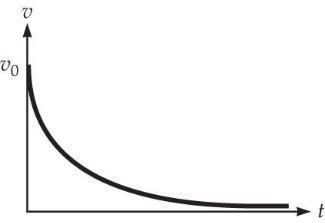
Figure QAns 2.1
This sketch represents an object ejected from a planet into space, for example from Earth’s surface. If the initial velocity is large enough, the object will always have a positive velocity. However, the acceleration is always negative (pointing toward the planet), so the velocity will diminish, but never reach zero.
Q2.2 Graphs for parts (a) and (b) are sketched below:
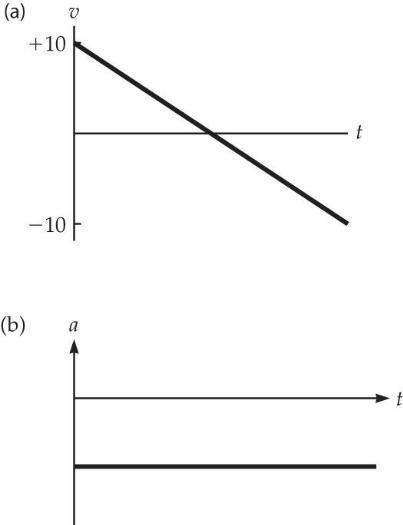
(c) On the trip upward, it has a positive (upward) velocity, which is getting smaller in magnitude. (We would say the ball is slowing down.) This represents a negative change in velocity over time, or a negative acceleration. On the way down, the ball has a downward (negative) velocity which is INCREASING in magnitude. This also represents a negative change in velocity over time or a negative acceleration, even though the ball is now “speeding up”!
Q2.3 See Figure QAns 2.3.
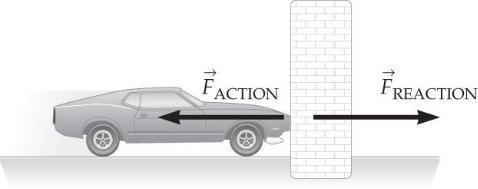
The wall provides the force on the car to cause it to stop. The reaction force is the force provided by the car on the wall which may do damage to the wall.
Q2.4 See Figure QAns2.4.
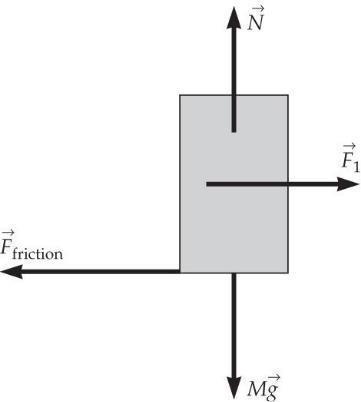
According to Newton’s second law, the acceleration of the refrigerator is due to the sum of the forces on the object. Your push is countered by a frictional force of equal magnitude and opposite direction. Here the forces on the refrigerator sum to zero, so the net force on the refrigerator is zero, thus making the acceleration of the refrigerator zero as well. Newton’s sec- ond law applies to the net force on an object, not just to the force you apply to the object.
Q2.5 According to Newton’s first law, the only way the velocity of an object can change is if there is a net force on the ob- ject. A car changes speed and/or direction when its tires expe- rience a force exerted by the road. If the road is too slippery, the tires can no longer apply these forces and therefore the ve- locity of the car does not change.
Q2.6 If the wheels of the car are slipping, they cannot apply any forces in the horizontal direction. Because there are no net forces on it, the car will remain at rest.
Q2.7 For an object orbiting at a constant speed about the origin (say a ball on the end of a string), the average velocity will be zero around the center point, but the speed will never change. A race car driving around an oval track is another example.
Q2.8 See Figure QAns2.8. An example of such a motion is when an object is moving at a constant speed in one direction.
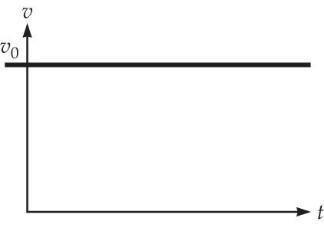
[SSM] Q2.9 Abracadabra! The place–settings are initially at rest (that is they have an initial velocity of 0 m/s). The principle of inertia states that a body will move with constant velocity unless acted upon by a force. Here the pulling of the tablecloth out from under the place–settings is done so quickly that the force and any associated acceleration on them is very small, and thus the place–settings barely change their velocity from 0.
Q2.10
(a) A spaceship leaving the surface of a planet, accelerated under the power of its engines.
(b) An apple falling from a tree.
(c) A car coming to rest as it approaches a stop light.
Q2.11 Yes it is possible. This happens all the time on race tracks. The cars start at the origin at t = 0. After just com- pleting a lap, they have a positive velocity, but they are back at the origin, i.e., the displacement is zero.
Q2.12
(a) Yes. The object’s acceleration is a constant value, and so is the same at all times. This makes the average acceleration the same as the acceleration at any instant.
(b)
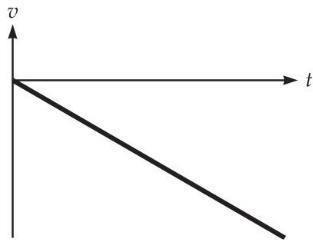
(c) No. As seen in answer (b), the velocity grows more negative with time. The average velocity over an arbitrary interval
is therefore not equal to the velocity at any instant.
Q2.13 See Figure QAns 2.13.

Note the large positive acceleration as the ball hits the ground.
Q2.14 See Figure QAns 2.14.
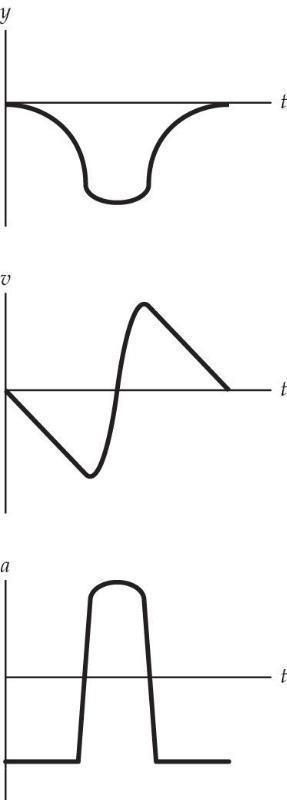
The force on the yo–yo is nonzero except for two instants in time when the acceleration reverses direction, as seen where the acceleration vs. time curve passes through zero.
[SSM] Q2.15 See Figure QAns 2.15.
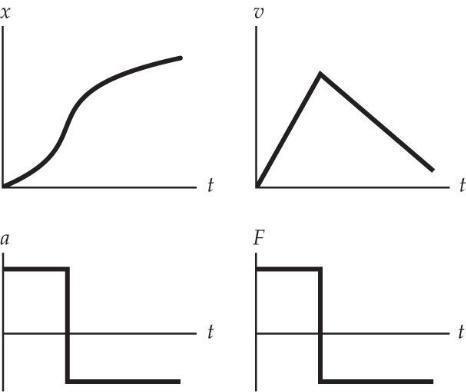
(a) Yes the person is exerting a force on the ball in order to
accelerate it upward. After the ball leaves his hand, he exerts no force on the ball.
(b) Yes the ball exerts a force on the person according to Newton’s third law of motion. The direction of this force is downward.
(c) The person does not accelerate because the Earth exerts an equal and opposite upward force on the person. The net force on the person is zero.
Q2.17
(a) The Moon’s acceleration is nonzero. The Moon’s speed may be pretty close to constant, but its direction is changing at every instant in time, so it must be accelerating.
(b) The force responsible for the Moon’s acceleration is the gravitational force the Earth exerts on the Moon.
Q2.18 If there is no acceleration, then there is no net force. In the case of the marble in honey it means that the forces acting on the marble are equal but opposite in direction, so when summed as vectors they are equal to zero. In this case the force of gravity is exactly equal and opposite to the drag force.
Q2.19
(a) Because the surface is frictionless, there are no horizontal forces and so the horizontal velocity is constant. The vertical forces (weight and normal force) do not affect the puck’s horizontal motion.
(b) Because the surface has friction, velocity is not constant, and the mug will accelerate opposite its motion.
(c) Because the surface has friction, velocity is not constant, and the car will accelerate opposite its motion.
Q2.20
(1) The force exerted on block 1 by the table, and the force exerted on the table by block 1.
(2) The force exerted on block 2 by block 1 and the force exerted by block 2 on block 1.
(3) The force exerted on block 3 by block 2 and the force exerted by block 3 on block 2.
Q2.21 See Figure QAns2.21.

Q2.22 If we let the direction the car is traveling be the positive direction, then:
(a) When the car is speeding up, the net force is in the positive direction.
(b) When the car is slowing down, the net force is in the negative direction.
(c) When the car moves at a constant speed, the net force is zero.
PROBLEMS
P2.1 Recognize the principle. Apply dimensional analysis. Sketch the problem. No sketch needed.
Identify the relationships. Dimensions of v : T L
Solve. Since velocity is a distance per time, we can see (a), (d), (e), and (f) are all velocities.
(c) is not because it is distance cubed per distance squared
multiplied by time squared, or distance per time squared, which is an acceleration.
(b) is not because it is distance per time squared, which is an acceleration.
(g) is not because it will be dimensionless, since it is a distance per distance.
What does it mean? Dimensional analysis should be used to check answers for appropriate units.
P2.2 Recognize the principle. Apply unit conversion. (Section 1.4)
Sketch the problem. No sketch needed.
Identify the relationships. Using the conversion 1 mi/h = 0.447 m/s, we can convert the miles per hour to m/s.
Solve. The solution to two significant figures is:
0.447 m/ s 400 mi/ h 180 m/ s 1 mi/ s
What does it mean? Note that 1 m/s is approximately 2 mi/h.
P2.3 Recognize the principle. Apply dimensional analysis. Sketch the problem. No sketch needed.
Identify the relationships. Dimensions of a : L T 2
Solve. Since acceleration is a distance per time squared, we can see (b), (c), (d), and (f) are all accelerations. Choice (c) is an acceleration because distance is cubed in the numerator and squared in the denominator. This cancels to leave distance in the numerator and time squared in the denominator, which are the dimensions of acceleration.
(a) is not because it represents distance per time, which is a velocity.
(e) is not because it also represents distance per time, which is again a velocity.
What does it mean? Dimensional analysis should be used to check answers for appropriate units.
P2.4 Recognize the principle. Apply unit conversion. (Section 1.4)
Sketch the problem. No sketch needed.
Identify the relationships. Looking up the conversion 1 m = 3.28 ft and applying this, we can calculate the acceleration in ft/s2 .
Solve.
9.8
2 3.28 ft 32 ft/ s2 1 m
What does it mean? This is the average value of the gravitational acceleration, the downward acceleration near the Earth’s surface. You will use this acceleration frequently in future chapters.
P2.5 Recognize the principle. The average speed is the total distance traveled per time.
Sketch the problem. No sketch needed.
Identify the relationships. The average speed is defined by:
Solve. Inserting the given values:
What does it mean? Since tells us nothing about the speed is a distance per time, this direction in which the runner moved.
* [Life Sci] P2.6 Recognize the principle. Apply graphical analysis of motion, including the definitions of velocity and acceleration.
Sketch the problem. See Figure Ans 2.6.
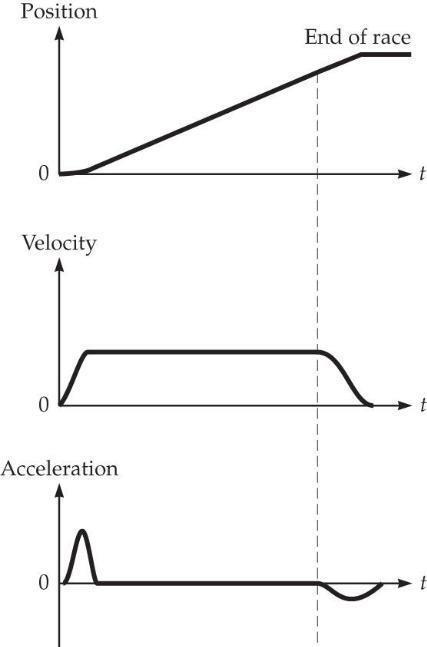
Figure Ans 2.6
Identify the relationships. Use the graphical techniques as discussed in Section 2.2.
Solve. See Figure Ans2.6. The runner will want to quickly accelerate (large positive acceleration, assuming the direction down the track is positive). Then assume approximately constant velocity until the finish, followed by a more gradual slowdown after the finish line (smaller negative acceleration).
What does it mean? While these graphs assume constant velocity during most of the race, the runner’s strategy might involve a further acceleration before the finish.
* P2.7 Recognize the principle. Analysis of motion. (Section 2.2)
Sketch the problem. No sketch needed.
Identify the relationships. His average velocity can be found using the definition of average velocity: the total distance traveled, xtot , divided by the time it took to travel that distance, ttot t1 t2 t3
Solve.
(b) The minimum velocity was when he was waiting at the stoplight,
and the maximum was 3.5 m / s . The average was closer to the maximam.
What does it mean? Note that the jogger did not run at the average velocity for any significant period of time (perhaps only an instant). This problem is useful in illustrating the difference between an average velocity and instantaneous velocity. The fact that the 30 seconds of zero velocity is included in the average makes an important point.
* P2.8 Recognize the principle. Apply graphical analysis of motion, including the definitions of velocity and acceleration.
Sketch the problem. See Figure Ans 2.8.
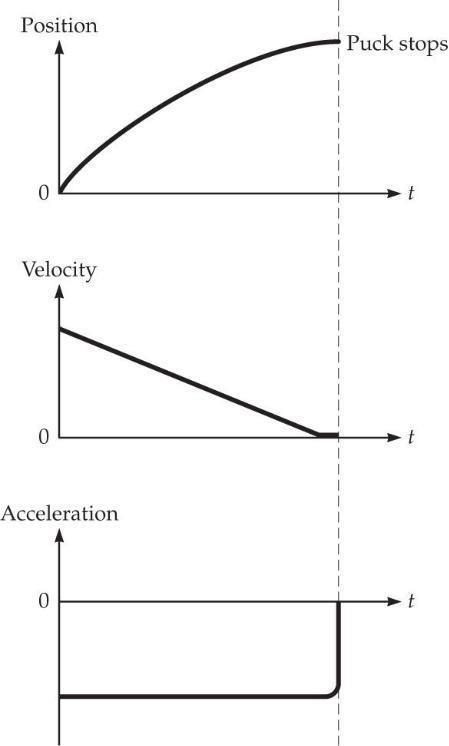
Figure Ans 2.8
Identify the relationships. Use the graphical techniques as discussed in Section 2.2.
Solve. See Figure Ans2.8. These graphs are sketched assuming that the direction of motion of the puck is the positive direction. The frictional force (and acceleration) will be nearly constant for this motion.
What does it mean? Note that the acceleration is negative be- cause the puck is moving in the positive direction and slowing down. The acceleration caused by friction will only exist until the puck comes to rest.
* P2.9 Recognize the principle. Apply graphical analysis of motion.
Sketch the problem. See Figure Ans2.9.
Another random document with no related content on Scribd:
H���� R���
The Hindu songs presided over by special gods were called rags, but of course, the name has no relationship whatever to our ragtime.
It seems that religious feeling has dominated everything in the Orient; for this reason every idea connected with music has a corresponding idea in Hindu mythology. The rags were all named after the gods who brought music down from heaven to comfort man. The character of each god or goddess was supposed to be reflected in the rag, and it was not the result of scientific study as were, for instance, the scales of the Chinese. Our knowledge of the rag has come down to us from what Sanskrit writers on Indian music have said, and what is practised today by the modern Hindu. No doubt Arabia and Persia once had a music system very much like this one of the Hindus.
Rags, ragas, or raginis were neither airs nor modes in our sense of the words, but something like the modes of the Arab songs, they were melodic forms, or themes, on which musicians either improvised or composed new songs, by using them in rhythms of endless variety.
There were many many rags, and they were under the guidance of the gods of the rainy season, the cold season, the mild, the hot, etc., and could only be sung during their special seasons. It was thought that these songs sung at the wrong time would bring down calamity. Again, as with the American Indian (Chapter II), we find tribes who are most careful to sing certain music at certain times.
It is told that a Hindu nobleman, long ago, tried to sing a night song in the daytime and darkness covered all things within the sound of his voice!
As important as was the song from the earliest time, instrumental music held almost an equal place.
O��������
The Hindu orchestra is sometimes large and sometimes small. Its dances are lively and vigorous, and very seldom slow and romantic. Nevertheless they have many kinds of songs, some lively and some not, such as: songs in honor of Krishna (one of their principal gods), official odes, war hymns, love songs, evening songs, wedding songs, cradle and patriotic songs. In some, the Arab seems to have influenced the Hindu music, because they have the lively rhythm and the variety of the Arab music, yet it is difficult to know which one influenced the other. The Arab music has the variety and luxurious soft beauty in popular dances equal to anything our modern musicians or poets have composed.
The playing of instruments, accompanying songs with Sanskrit texts, was supposed to give energy, develop heroism, make a peaceful heart, and drive away harm and impurity.
The members of the different castes or sects had and still have meetings held sometimes in private houses and sometimes in the temples, when they sang religious hymns. Among the higher classes, they went to the expense of having good musicians and of giving artistic performances, but among the common people, their idea was that the greater the noise the more they showed their devotion, so they sang, beat drums and blew whistles without any regard for time or melody, and you can imagine the effect was pandemonium.
N�������
It is impossible to write the Hindu music in European notation, because instead of dividing the scale into semi-tones or half-steps, they use quarter tones.
Margaret Glyn, in her book, Evolution of Musical Form, writes:
“In the East notation is in an elementary condition, the staff being unknown. The Hindus, Chinese, and Abyssinians have ancient notesigns, consisting of a kind of letter to which some indication of time is added, but in this respect the Chinese system is wanting, having practically no time-notation. Probably note-signs existed in Persia and Arabia, but these do not appear to have survived. The modern Arabic notation is but three hundred years old, and is said to have been invented by one Demetrius de Cantemir who adapted the letters of the Turkish alphabet for the purpose. This has eighteen tones to the octave (we have twelve), and is used in Turkey and other countries of the near East.”
The Hindus seem to like both triple (3 beats) and duple (2 or 4 beats) rhythm. The scheme changes according to the poetry of the song, and the pitch and the length of tones are shown by Sanskrit characters and special signs or words.
I����������
The Hindus have spent much time in studying music and the instruments of which they have many kinds. There are the strings, there are skins sounded by beating, instruments struck together in pairs, and those that are blown. They like the strings best. The characteristic instrument is the vina, usually of wood or bamboo strengthened by one to three gourds as sounding boards, and having five or seven wire strings played something like the zither, but sometimes with a bow. (Figure 16.) There are many varieties of the sitar, an instrument like a lute, and many viols of which the sarinda sarunja is typical and is played with a bow. (Figure 17.)
Among the percussion instruments are tambourines, castanets and cymbals; they had wind instruments such as flutes (seldom transverse or blown in from the side, and often played by blowing on them through the nostrils), trumpets, horns, bagpipes and oboes. Certain instruments were used only by the priests, others by beggars, and others by dancing girls. Imagine how weird a story could be told in music if a modern symphony orchestra played a piece of music telling of life among the Hindus. Maybe some of the readers of this book will get an idea for a Hindu tone poem, who knows?

Courtesy of the Metropolitan Museum of Art, New York City.
Hindu Instruments.
Fig. 15. Tabla drum. Fig. 16. Kinnari Vina, a stringed instrument.

Hindu Instruments.
Fig. 17. Sitar (Strings) Trumpet. Fig. 18.

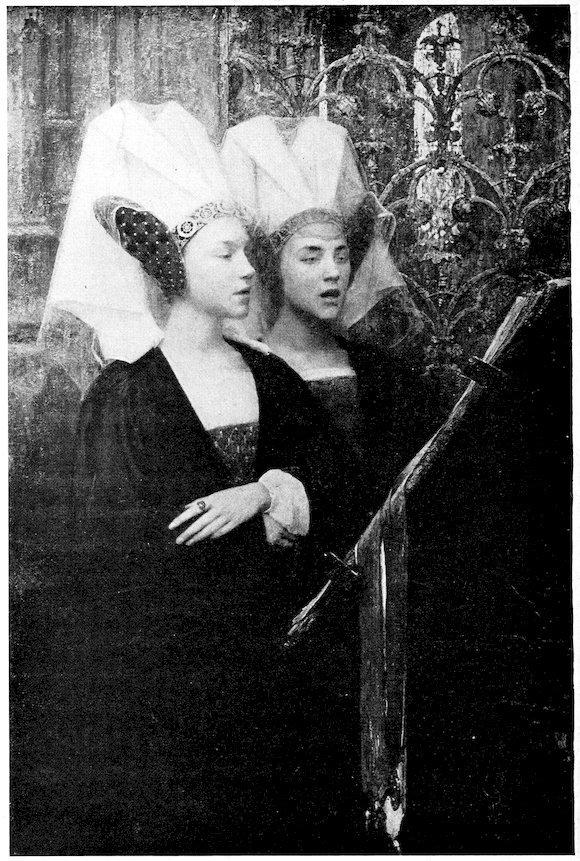 After a painting by Maxence, in Paris.
Book of Peace.
After a painting by Maxence, in Paris.
Book of Peace.
